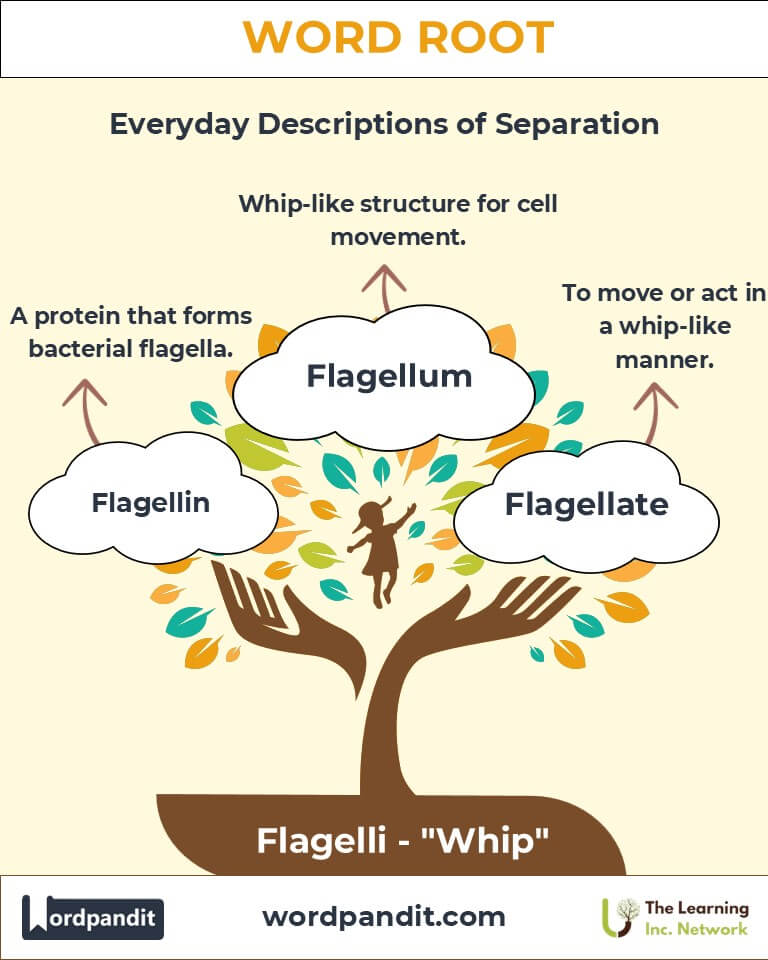Flagelli: The Root of Whipping Motion in Science and Language
Discover the fascinating journey of the word root "Flagelli," derived from the Latin word "flagellum," meaning "whip." From biology to everyday language, this root embodies movement, force, and precision. Words like "flagellum" and "flagellate" demonstrate how this root has shaped our understanding of cellular locomotion and figurative expression alike.

Table of Contents
- Introduction: The Dynamic Essence of Flagelli
- Etymology and Historical Journey
- Mnemonic: Unlocking the Power of Flagelli
- Common Flagelli-Related Terms
- Flagelli Through Time
- Flagelli in Specialized Fields
- Illustrative Story: Flagelli in Action
- Cultural Significance of the Flagelli Root
- The Flagelli Family Tree
- FAQs about the Flagelli Root
- Test Your Knowledge: Flagelli Mastery Quiz
- Conclusion: The Enduring Whip of Flagelli
1. Introduction: The Dynamic Essence of Flagelli
Imagine the graceful, whip-like motion of a sperm cell’s tail propelling it forward. This motion is captured by the root "flagelli," derived from the Latin "flagellum" (whip). Pronounced as fluh-jel-ee, this root underpins terms that highlight dynamic motion, force, and control.

2. Etymology and Historical Journey
The word "flagelli" traces its origins to the Latin flagellum, meaning whip or scourge. Originally used to describe tools for punishment, it evolved to describe whip-like structures in nature and mechanics.
3. Mnemonic: Unlocking the Power of Flagelli
Picture a single-celled organism wielding a tiny whip, using it to swim through water with remarkable agility.
Mnemonic Device: "Flagelli is the whip of motion, driving cells with precision and devotion."
4. Common Flagelli-Related Terms
- Flagellum: A whip-like appendage that enables cell movement.
- Flagellate: To whip or move using whip-like motions; also means to scold or punish metaphorically.
- Flagellation: The act of whipping, often as a form of punishment or religious devotion.
- Flagelliform: Shaped like a whip.
5. Flagelli Through Time
- Early Usage: "Flagellum" referred to whips used in ancient Rome.
- Scientific Revolution: In the 1600s, microscopes revealed cellular structures resembling whips.
- Modern Adaptations: Today, "flagellate" describes the locomotion of microorganisms.
6. Flagelli in Specialized Fields
Biology
- Flagellum: Essential for cell movement.
- Application: Understanding bacterial flagella has advanced antibiotic research.
Medicine
- Flagellate Protozoa: Organisms like Giardia use flagella for movement.
Mechanics
- Flagellar Motors: Biomimicry of bacterial flagella has inspired nano-motors.
7. Illustrative Story: Flagelli in Action
In the depths of a pond, a tiny bacterium named Felix relied on his flagellum to escape a predator. By whipping his tail with precision, Felix reached safety. Meanwhile, Dr. Marisol studied flagellar motion, leading to breakthroughs in nanotechnology.
8. Cultural Significance of the Flagelli Root
The whip, as symbolized by "flagelli," has played diverse roles in history and culture. In science, the flagellum reflects nature’s ingenuity, harnessing the whip’s dynamics for survival and innovation.

9. The Flagelli Family Tree
- Cili- (Latin: hair): Example: Cilium – hair-like structures aiding movement.
- Scourge- (Old French: whip): Example: Scourge – a tool or punishment.
- Vibr- (Latin: quiver): Example: Vibrissae – sensory hairs on animals.
FAQs About the Flagelli Word Root
Q: What does "Flagelli" mean?
A: "Flagelli" is derived from the Latin flagellum, meaning "whip." In language and science, it refers to whip-like structures or actions, such as the flagellum in biology, which propels cells like sperm or bacteria.
Q: What is a flagellum?
A: A flagellum is a whip-like appendage found in certain cells, enabling them to move. For instance, sperm cells use their flagella to swim toward an egg, and many bacteria rely on flagella for motility in liquid environments.
Q: How does "flagellate" differ from "flagellation"?
A: "Flagellate" refers to motion resembling the action of a whip, such as the swimming movement of flagellated protozoa. "Flagellation," on the other hand, describes the act of whipping, often associated with punishment or religious practices.
Q: Are flagella unique to bacteria?
A: No. While flagella are prominent in bacteria, they also appear in some eukaryotic cells, like sperm. However, their structure and functioning differ: bacterial flagella are rotary motors, while eukaryotic flagella rely on bending movements.
Q: What is a flagellar motor?
A: A flagellar motor is a microscopic, protein-based engine in bacteria that powers the rotation of the flagellum. It uses chemical energy from molecules like ATP to create movement, allowing bacteria to swim in their environment.
Q: What are examples of organisms that use flagella?
A: Organisms that use flagella include:
- Escherichia coli (a bacterium) for swimming in the gut.
- Euglena (a single-celled protist) for photosynthesis and movement.
- Human sperm cells, which use their flagella to reach an egg for fertilization.
Q: How do flagella aid in survival?
A: Flagella enable cells to move toward favorable environments, such as nutrient-rich areas, or away from harmful conditions. This movement, called chemotaxis, is essential for survival and reproduction in many microorganisms.
Test Your Knowledge: Flagelli Word Root Quiz
1. What does the root "flagelli" signify?
2. Which structure uses flagella for movement?
3. What is "flagellation"?
4. Which term describes something whip-shaped?
5. What field studies flagellate organisms?
12. Conclusion: The Enduring Whip of Flagelli
The root "flagelli" symbolizes the power of motion and force, from the microscopic world to cultural metaphors. Whether inspiring innovations in nanotechnology or enriching our vocabulary, "flagelli" continues to whip through time with relevance and dynamism.












